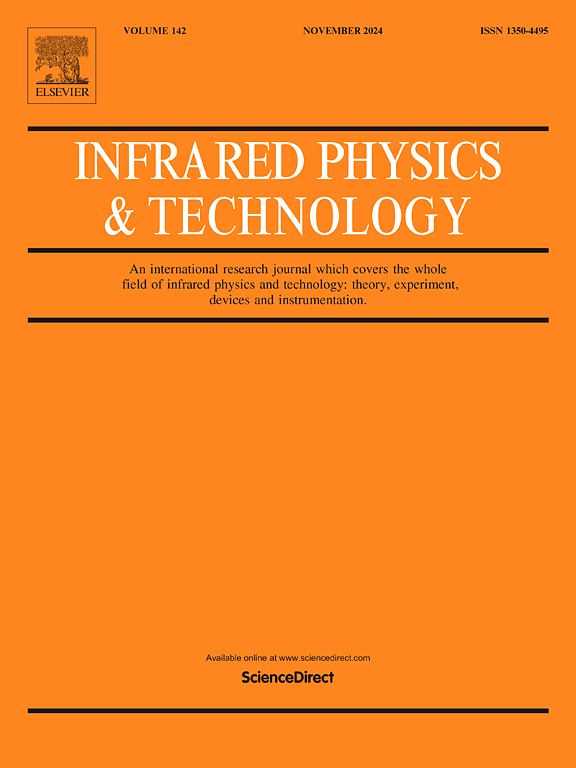基于“富gasb”引脚t2sls光电二极管的640 × 512 eSWIR焦平面阵列的演示
IF 3.1
3区 物理与天体物理
Q2 INSTRUMENTS & INSTRUMENTATION
引用次数: 0
摘要
本研究介绍了利用“富gasb”引脚型超晶格(T2SLs)光电二极管开发的扩展短波长红外(eSWIR)焦平面阵列(fpa)。我们成功地在GaSb衬底上展示了单带(SW)和双带(SW和MW)配置,采用带有类insb接口的迁移增强外延。器件在77 K下,SW和MW分别在2.7 ~ 2.8 μm和4.2 μm处出现光谱发光峰。该制造工艺采用了最先进的技术,包括双重钝化、衬底减薄和抗反射涂层,使其能够生产具有15 μm像素间距的640 × 512焦平面阵列。性能评估表明,单波段FPA可操作性为40%,探测率为1.28 × 109 cm·Hz1/2/W;双频FPA可操作性为97.75%,探测率为5.78 × 1010 cm·Hz1/2/W。这些结果强调了“富gasb”T2SLs在增强eSWIR成像技术方面的巨大潜力,为该领域的未来发展铺平了道路。本文章由计算机程序翻译,如有差异,请以英文原文为准。
Demonstration of 640 × 512 eSWIR focal plane array based on“GaSb-rich” pin-T2SLs photodiodes
This research presents the development of extended short-wavelength infrared (eSWIR) focal plane arrays (FPAs) utilizing “GaSb-rich” pin-type-II superlattices (T2SLs) photodiodes. We successfully demonstrated single-band (SW) and dual-band (SW and MW) configurations on GaSb substrates, employing migration-enhanced epitaxy with InSb-like interfaces. The devices exhibited spectral photoluminescence peaks at 2.7–2.8 μm for SW and 4.2 μm for MW at 77 K. The fabrication process incorporated state-of-the-art techniques, including double passivation, substrate thinning, and anti-reflection coatings, enabling the production of 640 × 512 focal plane arrays with a 15 μm pixel pitch. Performance assessments revealed that the single-band FPA achieved 40 % operability with a detectivity of 1.28 × 109 cm·Hz1/2/W, while the dual-band FPA demonstrated 97.75 % operability and a detectivity of 5.78 × 1010 cm·Hz1/2/W. These results underscore the significant potential of “GaSb-rich” T2SLs in enhancing eSWIR imaging technologies, paving the way for future advancements in this field.
求助全文
通过发布文献求助,成功后即可免费获取论文全文。
去求助
来源期刊
CiteScore
5.70
自引率
12.10%
发文量
400
审稿时长
67 days
期刊介绍:
The Journal covers the entire field of infrared physics and technology: theory, experiment, application, devices and instrumentation. Infrared'' is defined as covering the near, mid and far infrared (terahertz) regions from 0.75um (750nm) to 1mm (300GHz.) Submissions in the 300GHz to 100GHz region may be accepted at the editors discretion if their content is relevant to shorter wavelengths. Submissions must be primarily concerned with and directly relevant to this spectral region.
Its core topics can be summarized as the generation, propagation and detection, of infrared radiation; the associated optics, materials and devices; and its use in all fields of science, industry, engineering and medicine.
Infrared techniques occur in many different fields, notably spectroscopy and interferometry; material characterization and processing; atmospheric physics, astronomy and space research. Scientific aspects include lasers, quantum optics, quantum electronics, image processing and semiconductor physics. Some important applications are medical diagnostics and treatment, industrial inspection and environmental monitoring.

 求助内容:
求助内容: 应助结果提醒方式:
应助结果提醒方式:


